Le Mans Comes to Real Racing 3 in its Latest Update
One of the App Store's most well-known racers is getting yet another update with yet more content. This time, Real Racing 3 players can look forward to taking part in 10 full days of Le Mans.
One of the App Store's most well-known racers is getting yet another update with yet more content. This time, Real Racing 3 players can look forward to taking part in 10 full days of Le Mans.
Whether you’ve been playing Real Racing 3 for a while or are just getting started, chances are all you Apple Watch users are wondering what’s up with its watch functionality. Well, rather than acting as some weird sort of remote or letting you race directly on your wrist, it actually functions as a companion app. It’s not unlike a bizarre car-racing virtual pet now that I think about it...
Another week, another Real Racing 3 update; this time with a new Race Teams mode, more tracks, more cars, and... Apple Watch support?
Real Racing 3, known as that racing game from EA with breathtaking graphics, has received an update featuring a massive number of new car customization features. After you've used these new features to tweak your ride's height, its rims, and you've given your car one of a multitude of new vinyls, the update also lets you share your creation with friends using a new "Photo Mode" - allowing you to stop the action mid-race and capture a beautiful shot of your car.
Other new features in this version 2.1.0 update include new cars - Aston Martin’s DB9, Vanquish and V12 Vantage S - to add to your Real Racing experience, support for your favorite MFi iOS 7 controller, "Gold Achievements," and a "New All Star Vendetta Series."
You can get Real Racing 3 - and all the beautiful car tweaking features available in this update - on the App Store for free.
Over one million apps have made their way onto the App Store during its five years of existence. A million. That's a pretty miraculous number when you think about it. However it's not the amount of apps we have to pick from that I find so fascinating, but rather just how much things have changed since 2008. Pickings were comparatively slim at first, and many developers were just starting to dip a toe in the waters of Apple's new smartphone.
On top of that, the technology itself has changed tremendously in a relatively small amount of time. It makes me wonder if anyone from 2008 would even recognize current iOS devices, and by extension the App Store. Would a newer Apple initiate have any idea what they were looking at if they somehow managed to take a trip to five years ago? I think it warrants a look at how the hardware, the App Store, and the apps contained within it have evolved.
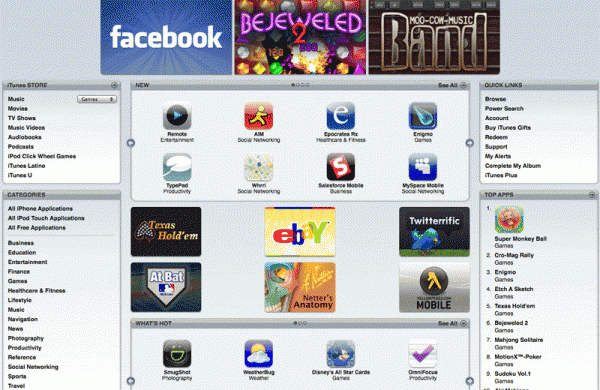
Handy apps like Pandora Radio, Last.FM, Facebook, and Yelp were to be expected, but that didn't make them any less impressive to have on a handheld platform. Others such as the intuitive personal organizer Evernote, the eerily accurate song-identifying app Shazam, eWallet’s convenient and secure account password management, and MLB At Bat with its extensive baseball coverage further capitalized on the particulars of the hardware and its general portability. Of course there were also some pretty unnecessary options out there, too. Flashlight kind of served a purpose but was also fairly pointless. It wasn't as bad as stuff like More Cowbell!, though.
At the same time, the games available on the App Store were beginning to show people that "mobile" didn't have to equal "mediocre." Sure there were a few simple ports of the odd classic such as Ms. PAC-MAN, Vay, and Scrabble, but there were also some impressive iOS renditions of popular console games like Super Monkey Ball coming out. Potential mobile gamers also had a few really special titles such as Galcon and Fieldrunners to tide them over. When all was said and done there were over 7,500 apps on the App Store by the end of the year, with more being added every day.

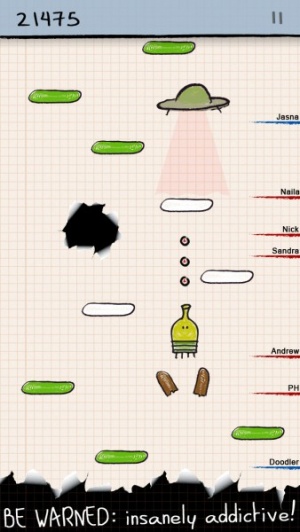
Many of the basic smartphone necessities were covered, but there was room for so much more. Especially while the technology was improving. Plenty of people used their iPhones as phones, sure, but with the addition of Skype they were able to enjoy the added functionality of instant messaging and voice chat without cutting into their data plans (so long as a wifi connection was present). Big companies were really starting to take notice as well. That same year Starbucks and many other big businesses threw their virtual hats into the ring with their own apps designed to make life a little bit easier for their iOS-using customers. Practicality was also becoming an even bigger focus. The Kindle app gave iOS users a practical e-reading option, and Dropbox was there being Dropbox. By which I mean "an awesome and super-convenient way to transfer files between multiple platforms." And this same level of refinement could be seen creeping into the games as well.
So many of the App Store's most notable games and franchises came out around this time. It was almost a mobile rennaisence of a sort. This was the year Real Racing first blew mobile gamers' minds, even causing some of them to question the legitimacy of in-game video footage until they were able to see the finished product for themselves. Zenonia was just a fledgling action RPG at the time, and while a lot of people liked it I doubt they knew just how many sequels it would spawn. The same goes for Pocket God, although with updates rather than multiple releases. Flight Control began to eat away at peoples' free time, Angry Birds and Doodle Jump hit it big (like, super big), and Myst and The Sims 3 further displayed the potential for major releases on mobile platforms. Oh, and Canabalt almost single-handedly invented and popularized a genre.
While games may not be the largest percentage of apps in the App Store (non-games lead the way overwhelmingly), they are the most popular single category, with over 151,000 active games in the App Store as of this month, according to 148Apps.biz.
One could argue, and indeed I will, that games are the most transformative type of app in the App Store, bringing a quality of play to iOS devices previously impossible to achieve. As 148Apps staffers have been heard to proclaim, there are over 1.2 billion thumbs waiting to play games on these crafty little devices.
Of course, there have been landmark games since the App Store went live in 2008, titles that create, extend, and improve on the current state of the art. Here then, are the top 20 of those games, as chosen by your App Experts at 148Apps.
Doodle Jump - This one started the jumping game craze, inspiring a host of clones and imitators along the way.
Angry Birds - Need we say more? The grumpy avians have taken over the public consciousness.
Tiny Wings - Not just another bird game, Tiny Wings showed us how one mechanic, brilliantly executed, could take an unknown designer to untold heights.

Candy Crush Saga - Good heavens we still get a lot of invites for this casual, money-printing game.
Clash of Clans - Say what you will about free to play, but this game has gotten it right.
Tiny Tower - Nimblebit hit the jackpot here with a smart combination of tower building and free to play retro gaming.
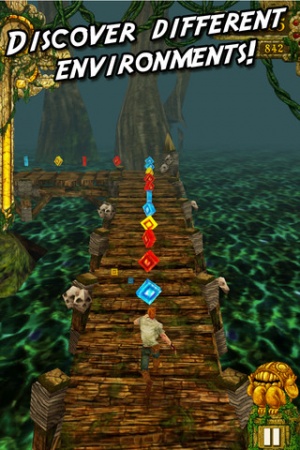
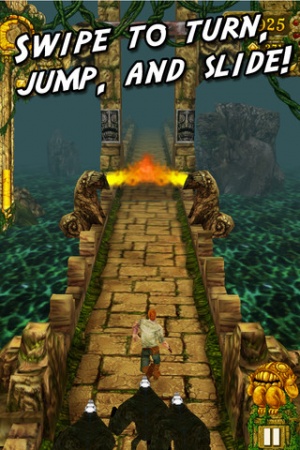
Temple Run - If anyone deserved to have a huge hit, it's the folks at Imangi Studios, who have been pushing the boundaries of quality gaming from the beginning. This one created the 3D endless runner genre at a breakneck speed!
Puzzles & Dragons - Another free to play darling, this one gets all the elements right to keep players entertained and paying.
Where's My Water? - Disney's breakout hit, with a new IP (intellectual property) and a fiendishly addictive mechanic.
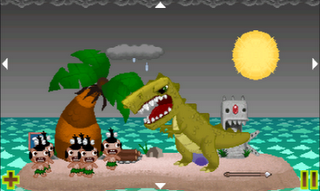
Pocket God - 47 updates later, still going strong and keeping kids of all ages entertained and laughing.
Minecraft Pocket Edition - The surprise PC hit the iPhone like a ton of cube-shaped bricks, letting crafters and miners of all stripe build and explore on the go.
Words with Friends - Scrabble with people you know. What's not to like? This one started the "with friends" genre with a bang.
Draw Something - Super successful, super quick, leading Zynga to buy the developer for a landmark price.
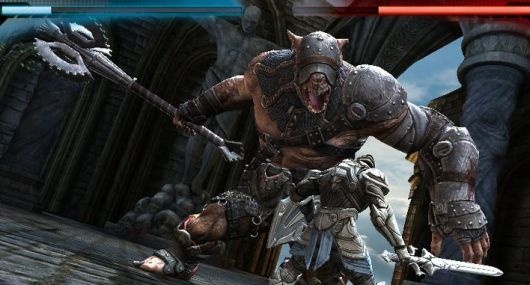
Infinity Blade - This game set the bar high for utter gorgeousness and a fighting mechanic that still sees itself in current games on the App Store, some two and a half years later.
Canabalt - Heard of the endless runner genre? Canabalt started it all with a one-touch game that exploded onto the scene in 2009 and has remained in the collective imagination ever since.
Superbrothers: Sword & Sworcery EP - This one proves again and again that the indie spirit can be captured and distributed via mobile, with a game that may never have gotten noticed on the bigger consoles.
Galaxy on Fire 2 - This space exploration and dogfighting game set the standard for utter gorgeousness, as well as finding a way to build a space sim on a tiny mobile device.

Spaceteam - Don't forget to flush the four-stroke plucker! Wait, what? Play this game with a few of your (drinking) friends, and you'll see what multiplayer party games *should* be like.
Real Racing - Still the gold standard for racing games on a mobile platform, the original game hit the starting line in 2011, with sequels upping the ante on visuals, controls, and profitability.
Super Hexagon - If you hate yourself, play this brutally difficult yet strangely compelling arcade game and thank indie developer Terry Cavanaugh in the morning.
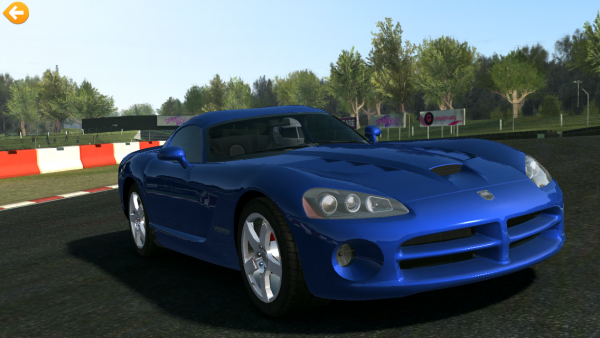
Of course that was just the beginning. There was also our look at Real Racing 3’s first true hands-on demo. And of course that whole free-to-play business that turned into something of a debacle. Let’s not forget the seething jealousy that was undoubtedly felt when we all found out both New Zealand and Australia were getting the game a couple weeks earlier than the rest of the world!
Before we knew it, Real Racing 3 was only a week away. Our lord and master, Jeff Scott, really dug into the mathematics at play and analyzed the in-game economic structure, for better or for worse. Blake Grundman followed with a look at the top 5 drool-inducing rides players can get their hands on (thus far), and soon after that Carter Dotson stepped up with a look at the 5 most alluring real-world racetracks on offer. Finally, the week was capped off with Carter’s in-depth look at Time Shifted Multiplayer while Jeff hopped back in the driver’s seat (sorry, I’m only human) one last time to bestow his Real Racing wisdom with an impressive number of tips and tricks. We also reviewed it, of course.
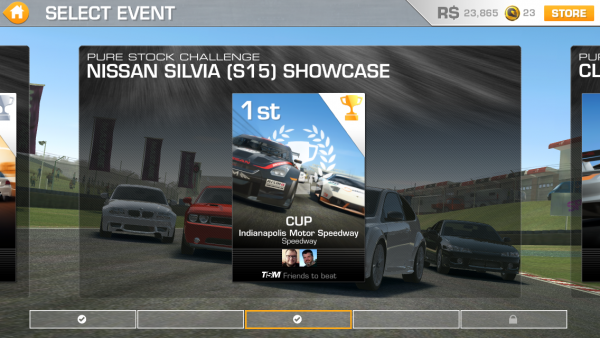
Since it’s been something of a non-stop Real Racing 3 party here at 148Apps we wanted to draw things to a close with a bit of style. Which is why we’re going to capitalize on all the spirit of Time Shifted competition and challenge you, our readers, to a race. Specifically the Pure Stock Challenge, Indianapolis Motor Speedway, Nissan Silvia (S15) Showcase Cup race pictured above. I think I’ve typed that out correctly. Why this event? Because it requires one of the first cars new players will have access to and doesn’t allow for any other; providing as even and easily accessible a playing field as we could find.
All you have to do is drive your heart out. Snap a screen shot (hit the Power and Home buttons on your iOS device at the same time) of your best time and post it in the comments below along with your Game Center username. We’ll pick random winners from all of the entries and post the results here on Monday (3/4) afternoon.
The prizes? We'll give away three $10 iTunes gift cards to spend how you see fit. Although in the spirit of the contest we’d suggest something like, oh, maybe the Race Car Booster Pack that includes 65 gold and a 2010 Dodge Viper SRT10 ACR-X?
Update: We'll contact our three winners via email. Thanks for playing and look for more Real Racing 3 contests coming up soon.
Now that Real Racing 3 is out, we are going to give you some tips to get the best times and have the most fun with Real Racing 3. All of that with an eye toward how you can minimize any real money investment in the game.
Real Racing is the most beautiful racer on any mobile platform, and it's free, so there is no reason not to try it. I've played Real Racing 3 for around 30 hours total now, let me give some tips on how to get the farthest possible in the shortest amount of time and without paying a thing.
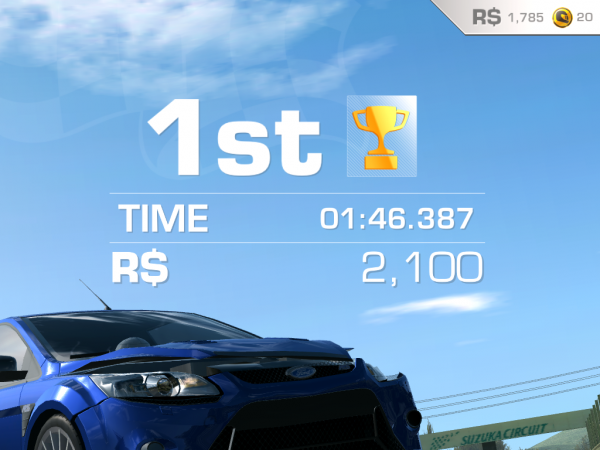
Manual brakes = faster times. The main tip I can give is one that I still haven't mastered completely myself, turn the braking assist to low or even better off. Of the three assists in the game it makes the most difference in your racing times/speed. When the computer does all of the braking for you, it does so very conservatively. If you can at least turn braking to low, it will greatly decrease your times. One thing to remember, you can change this in-race, at any time. Hit the pause button and you can then get to the settings in the lower left of the screen. (See more dirty tricks below)
Get inside, quickly! You start in last place in every single race. Seems unfair, but get used to it. You can usually jump up at least half way up the standings in the first couple turns with smart maneuvering. The key here is to not follow the car in front of you. If you do that you can only go as fast as they are going, and the car in front of them, etc. Pick your own path, preferably on the inside of the turn, and zoom past the other cars as they all line up and then slow down when the car in front of them does. It's best to not follow another car at any other time if at all possible, you get no advantage from drafting and will be more likely that you will need to slow down to avoid hitting the car you are following.
Build your stable of cars, smartly. You will need a single car that is one of the 3-4 for each circuit to race in that circuit. But you will need all of the cars in the circuit to complete it 100% as there will be races that require each car in the circuit. You should also note that most cars you purchase will be able to race in more than one circuit -- just check out the list on the main page to see the circuits you have access to.




















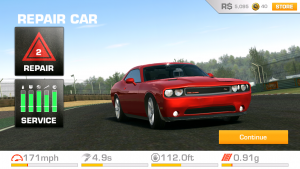
As the name (and the two previous releases) implies, this is a game about racing. Many of the features found in earlier releases are still around and will feel instantly familiar to veterans and fans: Tilt steering, tapping the screen to brake, automatic driving, tons (46 to start) of licensed vehicles, and showpiece visuals are all present and accounted for. However, even if someone doesn’t like the simplified auto-drive control system there is a wealth of customization options to suit their needs. Steering can be set to a virtual wheel rather than tilting, acceleration can be set to tap-and-hold, and every single assist (steering, braking, etc) can be turned on or off. There are also a wealth of race types available in the 961 included events ranging from cups to eliminations to drag racing to speed records and more. So there’s essentially something for everybody.
Real Racing 3’s spectacular visuals are without a doubt some of the (if not the) most impressive I’ve ever seen in an iOS game. Heck, they rival some console games I’ve played. Cars display damage, paint jobs actually reflect the environment around them including other cars, real world tracks have been painstakingly recreated, and each vehicle's interior has been lovingly reproduced with impressive detail. It’s a shame that the replay feature from the second game hasn’t made its way into this release since everything is so pretty and warrants showing off. However, more than the graphics it’s the sheer volume of content that really impresses me. That initial circuit I mentioned is massive. There are four different cars available to use for most of the events and a myriad of race types to keep things interesting. I’ve unlocked 24 individual events and I’m only 50% done. And it’s only one circuit out of over 25 that are available right now. All told there are 961 races included in this initial release. Running out of stuff to do will be incredibly difficult to say the least.

The system for notifications and match ups itself is also a little underwhelming at the moment. Knowing my time was beaten in a drag race is nice, but I should be able to jump right to said drag race without digging through menus trying to find it in the first place. I also feel like there should be an option to tap on a friend’s name on the main screen and see what races they’re currently leading in, rather than sifting through menu after menu looking for microscopic avatars. Not having such a feature seems like a huge oversight. With all that said it’s still a lot of fun to jump into a game and beat someone’s time knowing that they’re about to receive a notification that they’ve just been “served.”
Another hot button issue, as I’ve previously mentioned, is the freemium model. Rather than create a paywall or punish frugal iOS gamers, Firemonkeys has created a much friendlier model in theory that ties all real time waiting and premium currency to maintenance and repairs. Well, with the exception of custom paint jobs, final part upgrades, and two cars, anyway. The way it all works is that cars suffer wear and tear as they race, along with occasional body damage when things get rough. Replacing a bumper or windshield costs a little in app currency (referred to as “R$”), but it’s never so much as to offset anything earned from the race that caused the damage in the first place.
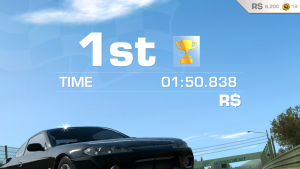
In a strange way, both of Real Racing 3’s major talking points didn’t quite pan out as expected or feared. The Time Shifted Multiplayer isn’t quite as ground-breaking as I was hoping it would be and still needs some work when it comes to the social elements, but it’s still decent fun and a good way to fan the flames of competition. Conversely the free-to-play model I’d been fearing would completely ruin the experience or even stonewall my enjoyment after a certain point turned out to be surprisingly unobtrusive and easy to work around. But ultimately neither of those things is important. What is important is that Real Racing 3 is just really darn fun to play and spectacularly gorgeous. Which is all I ever really wanted from it in the first place.
I feel lucky that I got a lot of time to play Real Racing 3. With well over an hour of playtime with Firemonkeys community manager Sam Mayo walking me through the game, I think I got a fairly good feel for Real Racing 3. That time with the game has just made my anticipation for the release greater.
I also got the opportunity to record a ton of video. Of the cars, some of the tracks and race types, the repair system, and more.
Late last night we brought you a 4:26 video walking through of Real Racing 3 that covered most aspects. We also detailed the energy system used in this free to play title. Today, let's go a little more in depth.
Wonder what the 46 cars are in Real Racing and wanted to see them? This video is for you. Here's a parade of all 46 cars where you can see their specs at the bottom of the screen.
A special note here. Some of the cars don't look perfect. The reason for that is the damage system in the game. If you damage the car while racing, that damage is persistent, much like it would be in real life. Your car will be represented as damaged anywhere in the game you see it. You can still race it, upgrade it, paint it, etc. But it will remain damaged, with it's performance reduced, until you spend the in game currency to repair it and wait the time it takes.
Now, back to that video.
Like most racing games, Real Racing 3 has upgrade and customization options. For Real Racing 3 you can make a variety of tiered upgrades to the Engine, Drivetrain, Suspension, Brakes, and the Wheels. Under each section there are from two to four tiered upgrades you can do. Meaning that you need tier 1 to apply tier 2, and so on. Each of these upgrades applied to a single car and has the possibility to increase the top speed, acceleration, braking, or traction of the vehicle. Each one should decrease your lap times by some amount.
Mount Panorama is aptly named. You race up this steep track on a mountain that never seems to end, crest the top to a beautiful panorama, and plunge right back down the other side. Awesomely rendered vistas, but better keep your eye on the road. I did make more than a few mistakes on this time trial / Autocross race while looking around the beautifully rendered track.
We also did a head to head race on the long and very fast Circuit de Spa, or just Spa. It's a great track and racer "drollted" provided a worthy challenge, until he made a mistake near the end of the first lap. It was bye bye from then on out as he had to take second place and I got the win!
Real Racing 2 was amazing with up to 16 cars in a single race. Real Racing 3 has bumped that up to 22 cars. In this Southbank race you'll see all 22 cars squeeze through a very narrow course. Southbank is the course through the streets of Melbourne. It's a track that doesn't exist and was just a fun experiment by the Firemonkeys team to add a brand new course. And a challenging one at that! This race gets a little dirty with lots of bumping and wall grinding in the narrow turns. I couldn't pull out a win on this one. It was my first drive on the track and I made too many mistakes. Those walls just jump right out at you! The best I could do was to climb from 22nd to a disappointing 6th. Even dirty driving can't win every time.
That's all we have right now. You can tell from all of the coverage we've been giving Real Racing 3 that we are anxiously awaiting it. Real Racing 3 comes out as a Universal build on iOS on February 28th. It also realeases for Android at the same time.
Note that this is a preview of Real Racing 3, not a review. We can never review an app when it's presented by people related to the app. The reason is that we have no idea how the game is tuned for that demo. We need to reserve judgement for the final release of the game, downloaded from the App Store, and set up just like it is for everyone else.
Lots of fresh new content this week at 148Apps.com, including a three part series tracking the history and development of Firemint's Real Racing series. Rob Rich writes, "The soon to be released Real Racing 3 is on a lot of iOS gamers’ minds these days, especially many of us here at 148Apps. Because of this we thought it would be a good idea to recap the series. In fact, we might have gone a bit beyond that and created a trilogy. First we’ll be taking a look at the series’ history and the history of Firemint, the Melbourne based studio that created the series. After that we’ll be taking a look at the design factors and what when into creating the first two Real Racing titles as well as a little of the third. And in the third part of this series, we’ll take a look at the new Time Shifted Multiplayer found in Real Racing 3."
Read Part One, Part Two and Part Three at 148Apps.
GiggleApps.com traded in the racing wheel for a stethoscope, as Amy Solomon reviewed Doctor Cat: "Doctor Cat is a cute children’s app allowing users to use different medicines to treat animals.
This app is bright and colorful, with a simple and sweet narrative about a cat finding a lost doctor’s bag and using its contents to treat creatures in need."
Find out more about this delightful new app for children by visiting GiggleApps today.
Read more about Intellacase at AndroidRundown.
Another week down, but oh so much more to report in the coming days and weeks! Keep track of the latest happenings by following us on Twitter, Facebook and Pinterest. You'll be glad you did. See you next week kiddies!
Earlier we took a look at the history of Real Racing as well as that of Firemint itself, then it was on to the nitty gritty details of the Real Racing series' gameplay design issues. Now it’s time to talk about what could be one of Real Racing 3’s most revolutionary features: Time Shifted Multiplayer.
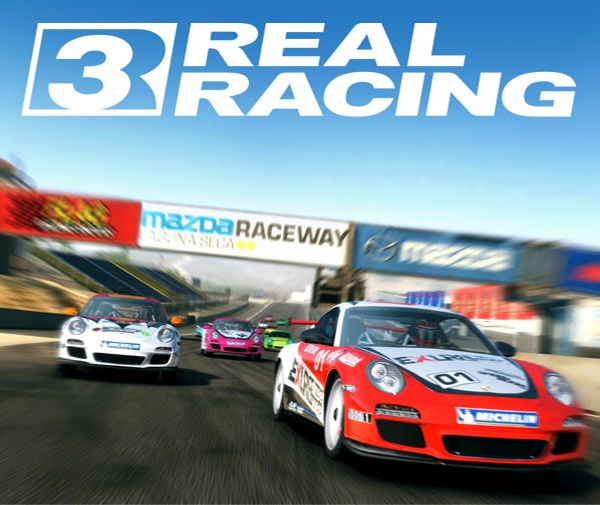
It’s great for playing anything turn-based on the go because it enables players to jump in and make their move whenever it’s convenient for them. Taking a break to get lunch, turning off the phone for a few hours during a long trip, or even taking a break partway through a match are all possible thanks to this particular form of multiplayer.
Real-time multiplayer games are a bit more difficult to execute on iOS devices. Not so much because the technology isn’t there, but because the very nature of mobile platforms creates a different sort of “flow” for users who aren’t tied down to a particular location. And Game Center is still in its relative infancy, so setting up a match among friends typically requires a decent amount of prep work. Especially given the sheer number of titles available for most Apple products these days. Capcom’s Street Fighter IV Volt and Marvel Vs. Capcom 2 are both examples of this particular multiplayer type, and both fun games, but setting up a match takes more work than it does on many gaming platforms.
The fast paced nature of the gameplay and the speed with which most bouts are completed fit the real-time online play well, but it still requires players to find a good spot to stop for a moment if they want to get a match or two in. Or they could also always play to their heart’s content while relaxing at home or any other location with proper seating and wireless internet.
Real Racing 3’s Time Shifted Multiplayer is a sort of amalgamation of both asynchronous and simultaneous play, and could very well lead to some significant changes in how we play mobile games with other people in the near future.
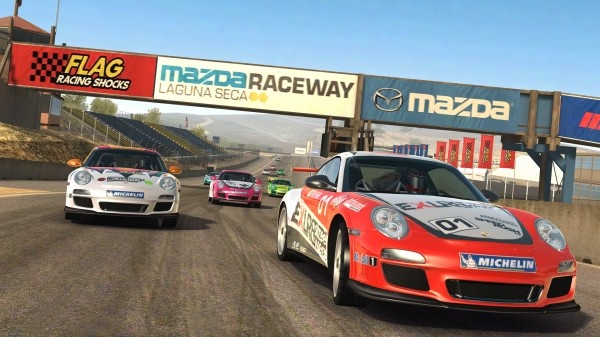
“What could we do if we had no limitations?” is the mantra that was used throughout Real Racing 3’s development according to the game’s Development Director, Kynan Woodman. “The answer to that question for many of us," he said, "is that we would be able to play against our friends and other real people anytime and anywhere.” It might not seem like a big deal but not everyone has the same daily schedule.
Anyone who’s ever tried to play games online with a friends who lives in another state, even one that’s in the same time zone, knows just how problematic it can be at times to try and coordinate. Being able to play with friends without needing to adhere to a specific schedule means everyone can play when they have a moment rather than having to set aside a specific time or possibly turn down an open invitation.
And thus Time Shifted Multiplayer was conceptualized. Without worrying about whether it was “possible” or not, they got to work figuring out a way to combine the accessibility of asynchronous play with the pulse-pounding action of simultaneous play. In essence, it’s meant to be the best of both worlds.

Firemonkeys hasn’t revealed the exact details of Time Shifted Multiplayer just yet, but it has explained the basics of how everything comes together in practice. When a Real Racing 3 player begins a race against someone else it’s not actually a direct competition.
Rather than racing against their opponent directly they’re in fact racing against “... their fully interactive time-shifted double," Woodman said, "which emulates their performance and skill.” In other words it’s like racing against their ghost, only this particular ghost is tangible. This “non-ghost” can be driven off the track, react to other racers jostling for position, and all the other stuff a real player would do automatically.
Imagine racing against a snapshot of another person; a sort of virtual player that’s compiled from data based around their particular skill level and performance. If left to its own devices it’ll achieve a time similar (if not equivalent to) the player’s original run, but that’s only if it’s left alone. This is, in essence, what Time Shifted Multiplayer is.
It’s never a good idea to get too far ahead of things when it comes to speculation, but it’s also incredibly difficult not to get swept up in all the Time Shifted Multiplayer madness. It’s a technology that combines the two primary forms of online play iOS users have come to rely on for all of their games, and as such stands to create quite a stir once more and more titles begin to adapt similar techniques. Fusing the play anywhere/anytime convenience typical of most mobile multiplayer games with the more directly interactive (and often more competitive) nature of real time multiplayer certainly seems like a brilliant idea on paper.
Firemint (and now Firemonkeys) has been on an interesting road trip up to now; full of all kinds of unexpected detours, the occasional paint job, maybe a trade-in here and there, picking up a few new passengers along the way, and bittersweet goodbyes to those who've been dropped off. Of course it's not over yet. There's still a lot of road to travel. We’ll have to wait until next month to see how well everything Firemonkeys has experienced and created comes together for the newest pit stop, but the potential is definitely there.
Last time we took a look at the history behind Firemint and its popular Real Racing series. In this post we are going to go into a bit more detail on just how these games came about: design troubles, device compatibility considerations, gameplay mechanics, and ideas that help to define a developer and its products. Enjoy!

The original Real Racing was developed in 2009: the middle of the iPhone 3G’s life cycle. Since the 3G was built around the earlier generations of iPhone, compatibility wasn’t too much of an issue. Real Racing 2, however, pushed things quite a bit further and gave the team a little difficulty when making it compatible with older devices. The game hit the App Store when the 3GS was still going strong and the iPhone 4 had only recently become available. According to Real Racing 3’s Development Director, Kynan Woodman, “Real Racing 2 was the first game where challenges with legacy hardware arose, but we managed to support everything back to the first iPhone on Real Racing 2.”
Even with a still comparably small list of devices and iOS software to worry about, things were starting to get more complicated. Firemint even went so far as to develop two separate base sets of code for its follow-up racing game: one designed to take full advantage of the iPhone 4 and fourth generation iPod touch’s specs, and one for everything that came before it. The different codes were then tailored to make the best use of their intended devices as possible by way of including different art assets, using higher framerates, etc.
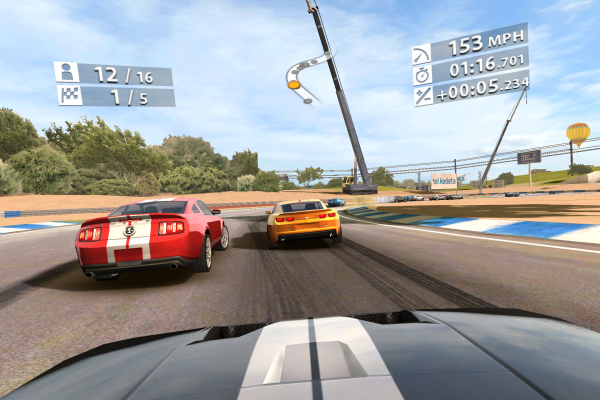
Real Racing 3, on the other hand, will most likely break with that tradition of near-universal iOS compatibility. A number of older devices are incompatible with iOS 6, and many of them also lack the processing power to manage more demanding games. Compatible devices haven’t been officially announced yet but Real Racing 3 is “... using Open GL ES 2.0 and relies on this for the advanced lighting," said Woodman. "Everything prior to the iPhone 3GS only supported OpenGL 1.0.” Given the specificity of that statement, it’s looking like support for anything predating the 3GS is off the table. It’s amazing to think that the lighting is what’s primarily responsible for the game’s hardware compatibility. Of course, iOS hardware upgrades are always an option and with each new release, prior versions become even more affordable.
What’s really interesting and even downright commendable about Firemonkey’s approach to Real Racing 3’s development, which began mid-2011, is the way it didn’t let hardware limitations dictate the design. “When we started developing Real Racing 3," Woodman said, "we started out with a core question: ‘What could we achieve, if we imagine, even just for a moment, that we have no limitations whatsoever.’” It was a question meant to steer (no pun intended) people away from worrying about whether or not their ideas would be feasible on any particular iOS device and get them thinking much more freely.
In other words, they tossed all preconceived limits out the window and let their imaginations run wild. So they got to work creating the racing game they wanted to create, with no consideration as to whether or not the hardware could handle any of it. “We went into this project anticipating hardware as powerful as the iPhone 5," Woodman said, "so when the iPhone 5 did come along, we were ready."
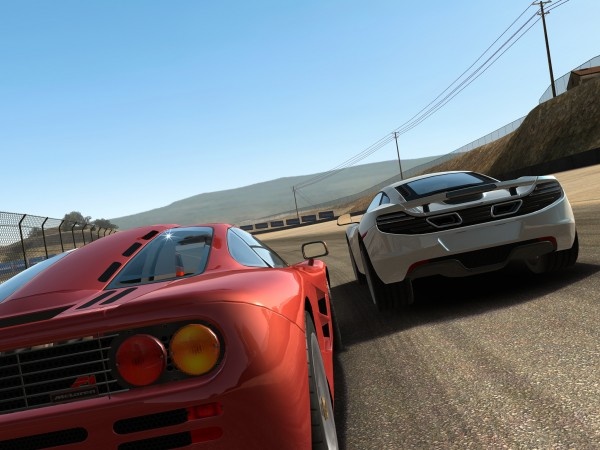
The idea was to design the game first, then worry about hardware specs later. It gave the team at Firemonkeys more of a chance to explore their ideas, and to play around with any concepts they could dream up and give them a real shot before deciding if they would work in Real Racing 3 or not.
So they worked backwards; developing Real Racing 3 as they saw fit, then hoping they could find a way to put it on Apple’s current and at the time future hardware. Ideas were given time to be fleshed-out rather than getting the axe early on thanks to the “no limits” approach. This led to the inclusion of an honest-to-goodness rearview mirror to help keep an eye on everyone currently eating your dust, a larger number of racers on the track (22 instead of the previous 16), new events that have never been used in a Real Racing game before that also sadly haven’t been specifically named, and real world racetracks like Indianapolis Motor Speedway and Silverstone.
Incorporating these tracks into Real Racing 3 is something that Firemonkeys is understandably excited about, especially considering all the work that went into the process. Each raceway needed to be thoroughly documented and multiple reference photos had to be taken. Once that step was finished it was time to research each track's elevation data and use it to create a close digital approximation. It's not a simple process, but the results are well worth it.
Of course, there's also the Time Shifted Multiplayer everybody’s been talking about that allows players to race against friends and foes anytime, anywhere. “We didn’t start out with Time Shifted Multiplayer," Woodman said, "we started out by putting real names on the cars and pretending that we had the ultimate multiplayer mode. It felt great and we worked our way back from there to Time Shifted Multiplayer.” It’s a method that’s resulted in some impressive new software technology that’s garnered a fair amount of attention since its announcement. It may not have ever come into being without such an open approach to design.
We’re still a ways off from Real Racing 3’s February release date, but that hasn’t kept people from talking about it. Not just the pretty graphics or the smooth controls, but also the unexpected surprises such as the Time Shifted Multiplayer which we'll be taking a look at in the next post in this series. Even so, Firemonkeys is still holding a few of its cards close to its vest. It’s exciting to take a moment to consider just what it is we haven’t been told yet.
The soon to be released Real Racing 3 is on a lot of iOS gamers' minds these days, especially many of us here at 148Apps. Because of this we thought it would be a good idea to recap the series. In fact, we might have gone a bit beyond that and created a trilogy. First we'll be taking a look at the series' history and the history of Firemint, the Melbourne based studio that created the series. After that we'll be taking a look at the design factors and what when into creating the first two Real Racing titles as well as a little of the third. And in the third part of this series, we'll take a look at the new Time Shifted Multiplayer found in Real Racing 3.
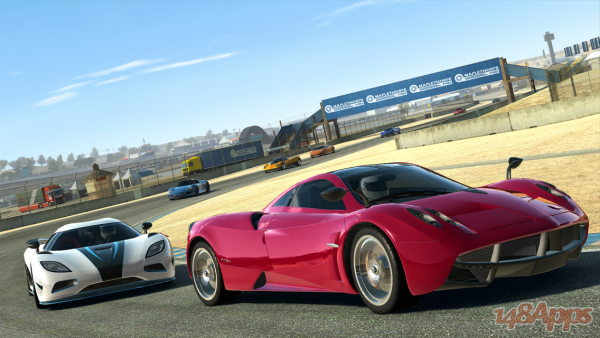
One of the best-known examples of how far developers can push Apple’s new iPhone 5 hardware is looming just over the horizon. However, it wasn’t always so. Sure the Real Racing series has steadily become pretty much synonymous with near console-quality visuals on mobile platforms, even going so far as to have a permanent spot on the App Store’s Big-Name Games and Racing Games lists, but there was once a time when no one knew the name Firemint. This was around four years ago, when most mobile games were still easily distinguished from virtually every other platform. You know, when Solitaire and box-pushing puzzles came preloaded on everything and acquiring new games wasn’t anywhere near as convenient as it is now. Oddly enough, the developer’s first major innovation wasn’t even based around graphics.
According to Kynan Woodman, Real Racing 3’s Development Director, the original Real Racing was actually more of an experiment than a real game. Specifically they were trying to figure out how to rig up accelerometer steering for a Nokia handset in a way that wasn’t awkward or unnatural. Keep in mind this was back in 2008, and up to that point attempts at such a control scheme would tilt the view along with everything else which wasn’t exactly conducive to a driving game. “To solve this problem we tilted the horizon dynamically to counter your steering of the device," he said, "so that regardless of where you moved the horizon in the game would match the real world. It seems obvious now, but no one had done it at the time.” Firemint didn’t just find a work-around for a common problem, the team developed a solution that set a new design standard for accelerometer controls.
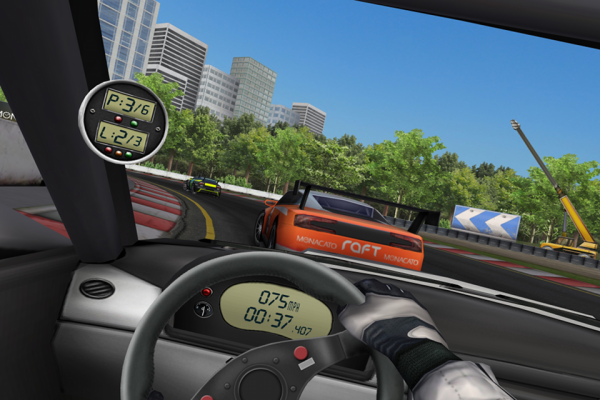
Once it had the horizon tilting figured out, Firemint began to construct the game that would eventually become Real Racing around it. “There was a lot more to the Real Racing franchise than great controls," said Woodman, "but it started with that as a key innovation.” As it turns out, innovation ended up being Firemint’s calling card of sorts.
The developer’s second major task was to construct an interior view that the series has come to be known for, “... so players could actually see the steering wheel move as they steered," Woodman said. It’s a feature that isn’t uncommon in console racing games these days (Codemasters’ Race Driver: Grid is a prime example), but it’s not prevalent in many - if any - iOS racers. The added level of detail, and by extension immersion, goes a long way to enhancing the “simulation” experience.
The decision to create a racing game built around closed tracks was made fairly early on in the cycle, however, but the rest of the design evolved as the game was developed. No one at Firement (now Firemonkeys) expected their project to become such a juggernaut on the App Store or to be the target of much speculation when early gameplay footage (above) was first revealed on PocketGamer in August of 2008. “We particularly enjoyed all the comments from consumers about how it was ‘clearly fake,’” said Woodman. Encouraged by these reactions, Firemint continued its work on through 2009, listening to fan and potential consumer feedback all the while. “We had a good idea of what people would like from the game," he said, "because we could read comments and talk to press and consumers about it. Although we couldn't do everything that players would like, we did use their feedback to help us focus the game design.”
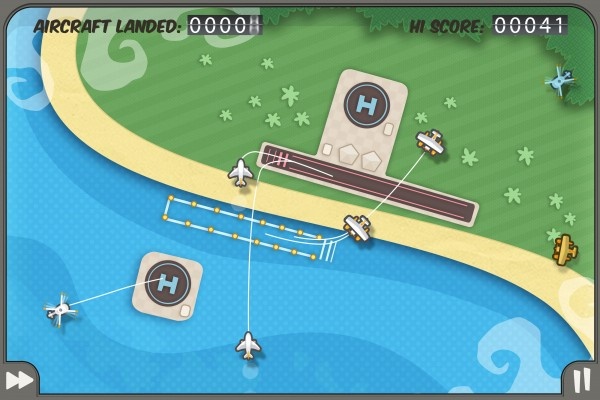
Amidst all the hullabaloo surrounding console-quality visuals and innovations up the wazoo it can be easy to forget that Firemint doesn’t only make racing games. In fact, before Real Racing came out, it was already flying high (*rimshot*) thanks to the success of Flight Control. This casual mobile rendition of a day in the life on an air traffic controller began as a simple experiment concocted by Firemint CEO Robert Murray. It was meant to be a simple design exercise created over the winter break when the studio was shut down for the holidays, but garnered so much attention around the studio that fellow Firemint designers, Alexandra Peters and Jesse West, hopped on board to help turn it into a full-blown game--a good call considering that it’s sold over half-a-million copies in its first month and well over three million to date.
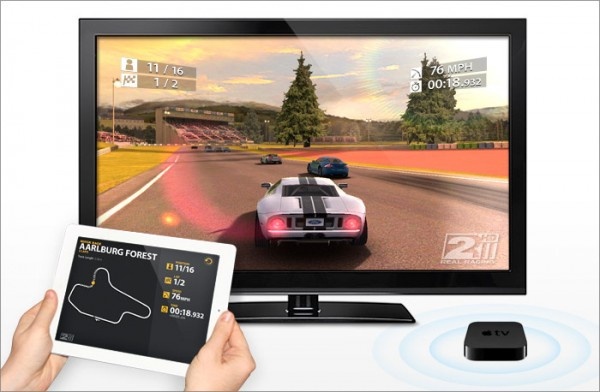
The original Real Racing went on to receive plenty of accolades, including 2010’s Apple Design and IMGA’s Excellence in Connectivity Awards, as well as a Best App Ever Award for Best Racing Game, Best Graphics, and Best Simulation Game in 2009. It’s also sold a whole bunch--and that’s just the first game. Not surprisingly, after Real Racing was launched in June of 2009, work on Real Racing 2 began roughly 6 months later.
The sequel to Firemint’s critical darling turned its fair share of heads as well when it was released in December of 2010. In addition to carrying over all the new concepts and special features that made the original Real Racing so noteworthy, Real Racing 2 added plenty of new items to its pedigree. The career mode was greatly expanded upon by allowing players to earn cash to purchase new cars and even upgrade their current ones. More camera options were added along with a special TV broadcast-style instant replay system. Vehicles were given damage models so that particularly rough races would leave telltale signs all over the racer’s cars. Online save options were added to allow players a chance to carry over their racing career when they installed the game to a new device. It was one of the first games to incorporate Apple’s Airplay technology which allowed players to view their games on their TV, using their iOS device as a stand-in for a controller. Actually, it allowed up to four players to view their games on the bigger screen all at once by way of the special Party Mode.
Last but not least, and in keeping with the whole “innovation” thing, Firemint also managed to include 16 player races (against AI in single player or 15 other people online), which was a first for iOS games at the time and no small feat in and of itself. All of these various features reportedly pushed Real Racing 2’s development costs to over $2 million. So it wasn’t just a first for iOS multiplayer, it was also a first for iOS development costs. Real Racing 2 has received a fair share of success with a combined (critic) Metacritic score of 94 to date along with taking the Best App Ever Awards for Racing and Graphics in 2010. With so many hits on Firemint's hands, it’s no wonder large publishers like EA took notice.
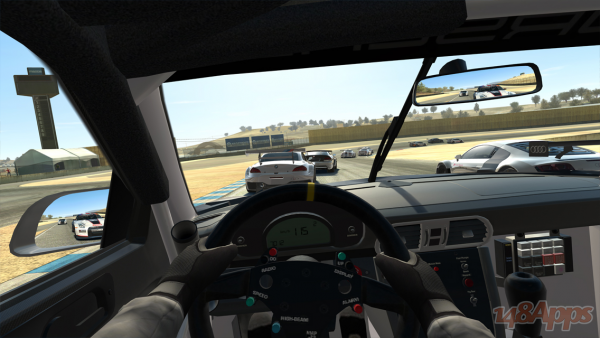
The following year, Firemint was absorbed into the collective that is Electronic Arts. Some were understandably concerned about the acquisition, as it’s not uncommon for smaller studios to lose most of what makes them special (or get dismantled entirely) once they become a part of a much larger whole. However, Firemint CEO Rob Murray, as well as EA Interactive’s Executive VP, Barry Cottle, were quick to put those fears to rest by recalling the developer’s history. Many of Firemint’s pre-Flight Control and pre-iOS releases (Need for Speed Most Wanted, Madden, etc) were created while under contract for EA Mobile. One could even argue that EA helped to shape the folks at Firemint into the dream team they are today. Getting bought by one of the largest video game publishers in the business while being able to maintain their creative freedom made for an exciting opportunity for the already quite successful developer. But it didn’t end there. In July of 2012, Firemint joined forces with IronMonkey Studios (Dead Space, Need for Speed Undercover) to create Firemonkeys. I hope they braced for all the inevitable Infernape jokes beforehand. Since then, EA’s involvement has most likely influenced Firemint’s/Firemonkey’s pricing structures, but overall it seems like they’ve left the developer to do their own thing, which is to make fantastic games.
A more recent and potentially troubling development was the announcement that Rob Murray--former CEO of Firemint, mastermind behind Flight Control, and Executive Producer at Firemonkeys--would be leaving to spend time as a full-time dad. It’s a perfectly good reason to step down and Tony Lay, EA’s Melbourne Studio GM, has more than enough experience to see Real Racing 3 to its release as the new Executive Producer, but it’s difficult not to have a little concern over what this means for Firemonkeys. Development heads come and go from time to time, as is the nature of the industry, but sometimes major shakeups can be difficult to shake off. There have also been rumblings of another kind of shakeup for Real Racing 3. The App Store is still a tough market to predict when it comes to pricing structure, and it’s rumored that Firemonkeys might do away with the premium price tag for their new racer. In fact, if the rumors are to be believed Real Racing 3 just might be free-to-play. It’s not definite by any stretch of the imagination at this point, but it is possible.
It’s impressive to think that Firemint accomplished all of this--several multi-award winning games, millions upon millions in cumulative sales, and a significant acquisition by a major publisher--in about three years' time. Where they go from here is anybody’s guess, but with Real Racing 3 looming on the horizon, the future definitely looks exciting, and pretty shiny.
Tomorrow, we'll delve into the design decisions and what it took to make the premier iOS racing game series, so stay tuned.
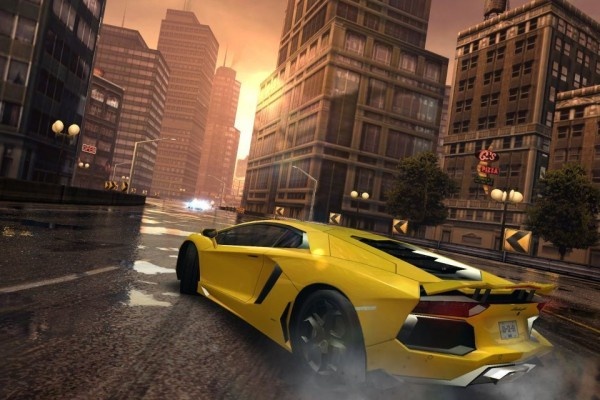
Console gamers tend to dismiss mobile games as dumbed down, casual, kids stuff. Whenever I write a column about how mobile games can be as "good" as console games, the outcry is often loud and fervent.
With the power of current-generation iOS devices, it’s not a stretch to consider that many games that we see on consoles could be ported to mobile devices almost as is with the full game intact. And yet, it does indeed seem that when titles have a console and a mobile version of the same game, the mobile version suffers in terms of content.
Why is that? Even if we assume for the moment that an iOS device can’t push the same high quality graphic power as a dedicated gaming console, why must games on mobile be so much less in-depth than their console brethren?
Nick Rish, vice president of mobile publishing for EA, believes that comparing the two is futile. “There is something very immersive about holding a device 10 inches from your face,” he said, “putting on headphones and enjoying a game like Need for Speed Most Wanted while on your lunch break … It’s tough to say one platform provides a better consumer experience than the other; gaming is in the eye of the beholder.”
"Mobile gaming grew from very basic flash games we all've been playing on web browsers," said Przemek Marszal, art director at 11 bit studios, the developer behind the Anomaly Warzone series. But that's changing, he said, noting that even a hard-core indie developer like John Carmac sees the potential of iOS gaming.
"I think hardcore gamers should expect the "same level" of experience and immersion but not the exact same experience," said Marszal. "iOS is about touch, mobile, close-to-your-eyes feel, immediate experience. For a console, you almost need to "plan" your time with it." He noted that the gap between console and iOS is narrowing, however, saying that the iPad 4 and iPad 5 is about as powerful as the original XBox.

So why don’t we see more console-like experiences on iOS and other mobile devices? Could it be the business model? Rish referenced the fact that with consoles and dedicated handheld gaming devices, consumers pay for their games up front, often spending twenty, thirty, sixty dollars or more for the entire experience. “We are seeing that when a developer gives a mobile game away for free,” said Rish, “there is more of a focus on replay-ability and the continual development of the experience through content updates, which prolong the experience, as opposed to creating an in-depth story from the beginning with a definite end.”
Could it also be that developers and publishers who do business in both worlds want to avoid cannibalizing their sales numbers? Our focus has always been on building an incredible experience on mobile that can sit alongside, rather than replicate, the console title,” said de Graaf. With gamers clamoring for high-quality realistic gaming experiences on living room consoles, a company would be hard pressed to give that up and move all its gaming resources to the iOS world, right?
Mobile titles, then, are like extra DLC, available to gamers who own both an iOS device as well as a console. They also function as advertisements for their console versions, driving even more sales to the publisher and developer than anything else.
While games on iOS can offer near-console quality and depth, then, perhaps consumers are, in fact, driving the types of games that show up on mobile devices. Rish pointed out that mobile gamers tend to prefer shorter play sessions when on the go, as well as the ability to immerse themselves into a deeper game as they have the time for.
Seropian makes a distinction between the scope of a game and it's depth. A deep game, he says, "is one you can play over and over again, the same bits, and get better at it and continue to enjoy it. A game with scope is a longer game with more things to look at and lots of single use content." He points out that creating a console-type game with scope isn't the best strategy for success, as people use their devices differently than they game on consoles. "The real trick," he said, "is marrying those depth elements - compelling story, fantastic artistry and deep game mechanics with that accessible and quicker structure."
The benefit of mobile gaming, then, may in fact be ability to serve many types of people by providing many different types of gaming experiences. It’s much easier to have some shorter, more casual experiences available on the same iOS device as the more console-like games with depth and immersive gameplay.

It’s the publisher’s job, then, to differentiate the mobile titles even more, if that’s the case. It also doesn't quite explain why there aren't at least SOME games with the kind of depth and immersiveness we expect from console games made by the larger gaming companies like EA.
In addition, maybe the games we're looking for, the ones with depth, significant gameplay,storytelling, and amazing graphics, won't be found fromt he larger publishers. Perhaps we'll only see them from smaller, less risk-averse companies who don't need to worry about a console vs. mobile version.
If companies want to make games to meet their customer's needs, then there should certainly be a market for deeper, console-style type games on iOS. Here's hoping that the increasing power and ability of mobile devices continues to allow game publishers to create a few more deep, long-form video games for our favorite mobile platforms.